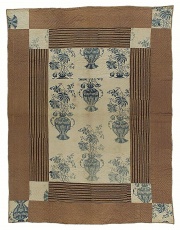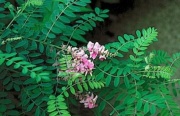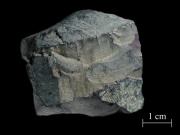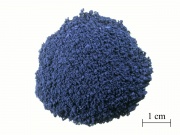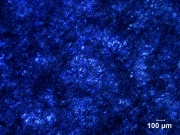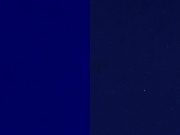Difference between revisions of "Indigo"
(username removed) |
(username removed) |
||
| Line 1: | Line 1: | ||
| − | [[File:49.414-SC2674.jpg|thumb|''' | + | [[File:49.414-SC2674.jpg|thumb|'''MFA Acc. #:''' 49.414]] |
| − | |||
| − | |||
| − | |||
| − | |||
| − | |||
| − | |||
| − | |||
| − | |||
== Description == | == Description == | ||
A natural dark blue dye obtained from ''Indigofera tinctoria'' plants native to India, Java, Peru, and other tropical areas. The use of indigo was first mentioned in Indian manuscripts in the 4th century BCE. It was exported to Europe in Roman times but did not become plentiful until sea routes opened up in the 17th century. The natural material is collected as a precipitate from a fermented solution of the plant. The coloring component, indigotin, is extracted as a colorless glycoside, but turns blue with oxidation. Synthetic indigo was first produced in 1880 by Adolf von Baeyer. Made from anthranilic acid, the synthetic colorant is chemically identical to natural indigo and has almost entirely replaced the natural dyestuff. Indigo is a fine, intense powder which may be used directly as a pigment in oil, tempera, or watercolor media. The exposed pigment can fade rapidly in strong sunlight. Indigo is still used to dye jeans, where its fading and uneven coloring have become favorable characteristics. | A natural dark blue dye obtained from ''Indigofera tinctoria'' plants native to India, Java, Peru, and other tropical areas. The use of indigo was first mentioned in Indian manuscripts in the 4th century BCE. It was exported to Europe in Roman times but did not become plentiful until sea routes opened up in the 17th century. The natural material is collected as a precipitate from a fermented solution of the plant. The coloring component, indigotin, is extracted as a colorless glycoside, but turns blue with oxidation. Synthetic indigo was first produced in 1880 by Adolf von Baeyer. Made from anthranilic acid, the synthetic colorant is chemically identical to natural indigo and has almost entirely replaced the natural dyestuff. Indigo is a fine, intense powder which may be used directly as a pigment in oil, tempera, or watercolor media. The exposed pigment can fade rapidly in strong sunlight. Indigo is still used to dye jeans, where its fading and uneven coloring have become favorable characteristics. | ||
| − | [[File:indigo tinctoria t.jpg|thumb|]] | + | [[File:indigo tinctoria t.jpg|thumb|Indigo plant |
| + | (''Indigofera tinctoria'')]] | ||
== Synonyms and Related Terms == | == Synonyms and Related Terms == | ||
2,2'-biindolinyliden-3,3'-dion; '' Indigofera tinctoria''; Natural Blue 1; CI 75780 (natural); Vat Blue 1; CI 73000 (synthetic); Pigment Blue 66; indigotin; indicum (Pliny); indigo (Esp. Fr., Dan., Ned., Port., Sven.); Indigo (Deut.); anil (Esp.); Indiko (Gr.); indaco (It.); aneel; anile; ai (Jap.); rams (Tibetan); blue ynde; blue inde; anneil; India blue; intense blue; rock indigo; stone blue; indigo carmine; intense blue; indico; indicoe; indego; nil | 2,2'-biindolinyliden-3,3'-dion; '' Indigofera tinctoria''; Natural Blue 1; CI 75780 (natural); Vat Blue 1; CI 73000 (synthetic); Pigment Blue 66; indigotin; indicum (Pliny); indigo (Esp. Fr., Dan., Ned., Port., Sven.); Indigo (Deut.); anil (Esp.); Indiko (Gr.); indaco (It.); aneel; anile; ai (Jap.); rams (Tibetan); blue ynde; blue inde; anneil; India blue; intense blue; rock indigo; stone blue; indigo carmine; intense blue; indico; indicoe; indego; nil | ||
| − | [[File:indigo_piece_1.jpg|thumb| | + | [[File:indigo_piece_1.jpg|thumb|Indigo piece |
| + | (''Indigofera tinctoria'')]] | ||
== Other Properties == | == Other Properties == | ||
| Line 25: | Line 19: | ||
Microscopically, indigo has fine, translucent dark blue, rounded particles that are weakly birefringent and appear red under Chelsea filter. | Microscopically, indigo has fine, translucent dark blue, rounded particles that are weakly birefringent and appear red under Chelsea filter. | ||
| − | [[File:indigo_powder.jpg|thumb| | + | [[File:indigo_powder.jpg|thumb|Indigo powder |
| − | + | (''Indigofera tinctoria'')]] | |
{| class="wikitable" | {| class="wikitable" | ||
|- | |- | ||
| Line 45: | Line 39: | ||
|} | |} | ||
| − | [[File:indigo_50X2.jpg|thumb| | + | [[File:indigo_50X2.jpg|thumb|Paper dyed with indigo]] |
| − | |||
== Hazards and Safety == | == Hazards and Safety == | ||
| Line 52: | Line 45: | ||
Fisher Scientific: [https://fscimage.fishersci.com/msds/62055.htm MSDS] | Fisher Scientific: [https://fscimage.fishersci.com/msds/62055.htm MSDS] | ||
| − | [[File:dyed indigo.jpg|thumb| | + | [[File:dyed indigo.jpg|thumb|Paper dyed with indigo]] |
| − | |||
== Additional Information == | == Additional Information == | ||
­ H.Schweppe, "Indigo and Woad", ''Artists Pigments'', Volume 3, E. West FitzHugh (ed.), Oxford University Press: Oxford, 1997. Pigments Through the Ages: [http://webexhibits.org/pigments/indiv/overview/indigo.html Indigo] | ­ H.Schweppe, "Indigo and Woad", ''Artists Pigments'', Volume 3, E. West FitzHugh (ed.), Oxford University Press: Oxford, 1997. Pigments Through the Ages: [http://webexhibits.org/pigments/indiv/overview/indigo.html Indigo] | ||
| − | [[File:Indigo C100x.jpg|thumb| | + | [[File:Indigo C100x.jpg|thumb|Indigo]] |
== Comparisons == | == Comparisons == | ||
Revision as of 11:44, 27 April 2013
Description
A natural dark blue dye obtained from Indigofera tinctoria plants native to India, Java, Peru, and other tropical areas. The use of indigo was first mentioned in Indian manuscripts in the 4th century BCE. It was exported to Europe in Roman times but did not become plentiful until sea routes opened up in the 17th century. The natural material is collected as a precipitate from a fermented solution of the plant. The coloring component, indigotin, is extracted as a colorless glycoside, but turns blue with oxidation. Synthetic indigo was first produced in 1880 by Adolf von Baeyer. Made from anthranilic acid, the synthetic colorant is chemically identical to natural indigo and has almost entirely replaced the natural dyestuff. Indigo is a fine, intense powder which may be used directly as a pigment in oil, tempera, or watercolor media. The exposed pigment can fade rapidly in strong sunlight. Indigo is still used to dye jeans, where its fading and uneven coloring have become favorable characteristics.
Synonyms and Related Terms
2,2'-biindolinyliden-3,3'-dion; Indigofera tinctoria; Natural Blue 1; CI 75780 (natural); Vat Blue 1; CI 73000 (synthetic); Pigment Blue 66; indigotin; indicum (Pliny); indigo (Esp. Fr., Dan., Ned., Port., Sven.); Indigo (Deut.); anil (Esp.); Indiko (Gr.); indaco (It.); aneel; anile; ai (Jap.); rams (Tibetan); blue ynde; blue inde; anneil; India blue; intense blue; rock indigo; stone blue; indigo carmine; intense blue; indico; indicoe; indego; nil
Other Properties
Soluble in nitrobenzene, phenol, chloroform, glacial acetic acid. Insoluble in water, ethanol, acetone, ethyl acetate, pinene. Absorption max = 599 (in xylene). ISO R105 Lightfastness Classification = 3-4 Microscopically, indigo has fine, translucent dark blue, rounded particles that are weakly birefringent and appear red under Chelsea filter.
| Composition | C16H10N2O2 |
|---|---|
| CAS | 482-89-3 |
| Melting Point | 390-392 |
| Molecular Weight | mol. wt. = 262.26 |
| Refractive Index | >1.662 |
Hazards and Safety
Discolored by reducing agents and bleaches. Fisher Scientific: MSDS
Additional Information
H.Schweppe, "Indigo and Woad", Artists Pigments, Volume 3, E. West FitzHugh (ed.), Oxford University Press: Oxford, 1997. Pigments Through the Ages: Indigo
Comparisons
Characteristics of Common Blue Pigments
Authority
- Nicholas Eastaugh, Valentine Walsh, Tracey Chaplin, Ruth Siddall, Nicholas Eastaugh, Valentine Walsh, Tracey Chaplin, Ruth Siddall, Pigment Compendium, Elsevier Butterworth-Heinemann, Oxford, 2004
- The Dictionary of Art, Grove's Dictionaries Inc., New York, 1996 Comment: 'Pigment'
- Ralph Mayer, Ralph Mayer, A Dictionary of Art Terms and Techniques, Harper and Row Publishers, New York, 1969 (also 1945 printing)
- Palmy Weigle, Palmy Weigle, Ancient Dyes for Modern Weavers, Watson-Guptill Publications, New York, 1974
- Matt Roberts, Don Etherington, Matt Roberts, Don Etherington, Bookbinding and the Conservation of Books: a Dictionary of Descriptive Terminology, U.S. Government Printing Office, Washington DC, 1982
- Dictionary of Building Preservation, Ward Bucher, ed., John Wiley & Sons, Inc., New York City, 1996
- The Merck Index, Martha Windholz (ed.), Merck Research Labs, Rahway NJ, 10th edition, 1983 Comment: entry 4977
- A.Scharff, A.Scharff, 'Synthetic dyestuffs for textiles and their fastness to washing', ICOM-CC Preprints Lyon, Getty Conservation Institute, Los Angeles, 1999
- Hermann Kuhn, Hermann Kuhn, Conservation and Restoration of Works of Art and Antiquities, Butterworths, London, 1986
- Thomas B. Brill, Thomas B. Brill, Light Its Interaction with Art and Antiquities, Plenum Press, New York City, 1980
- R.Feller, M.Curran, C.Bailie, R.Feller, M.Curran, C.Bailie, 'Identification of Traditional Organic Colorants Employed in Japanese Prints and Determination of their Rates of Fading', Japanese Woodblock Prints, Allen Memorial Art Museum, Oberlin College, Oberlin, 1984
- F. Crace-Calvert, F. Crace-Calvert, Dyeing and Calico Printing, Palmer & Howe, London, 1876
- Random House, Random House, Webster's Encyclopedic Unabridged Dictionary of the English Language, Grammercy Book, New York, 1997
- Encyclopedia Britannica, http://www.britannica.com Comment: "indigo" Encyclopdia Britannica from Encyclopdia Britannica Premium Service. [Accessed May 6, 2004].
- Colour Index International online at www.colour-index.org
- Book and Paper Group, Book and Paper Group, Paper Conservation Catalog, AIC, 1984, 1989
- The American Heritage Dictionary or Encarta, via Microsoft Bookshelf 98, Microsoft Corp., 1998
- Art and Architecture Thesaurus Online, http://www.getty.edu/research/tools/vocabulary/aat/, J. Paul Getty Trust, Los Angeles, 2000
- Website address 1, Website address 1 Comment: Pigments Through the Ages: http://webexhibits.org/pigments/indiv/history/indigo.html
